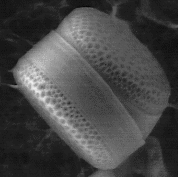 (Electron microscope
image of a diatom shell)
(Electron microscope
image of a diatom shell)
Diatoms are single celled algae with a shell made out of silica, which are capable of living in fresh or marine water. These organisms are extremely important to life on earth. These microorganisms are part of the phytoplankton ( from the Greek word phyton meaning plant), phytoplankton drifts in the ocean currents in the photic zone(top 30 m of the water column). Phytoplankton are extremely important because of their generation of large amounts of atmospheric oxygen and their energy contribution to the food chain. Diatoms are photoautotrophs, which means that they use solar energy to drive the synthesis of energy rich organic molecules from simple inorganic starting materials, such as carbon dioxide and water. Diatoms are very efficient photosynthesizers, about 55% of the energy they absorb from the sun is converted into energy of carbohydrate chemical bonds, which is one of the most efficient rates known. Excess oxygen not needed in cellular respiration is released through perforations in its shell into the water, where it is absorbed by other organisms, sediment or diffused into the atmosphere, this includes at least some of the oxygen we breathe. Diatoms are important also because of their use in environmental studies, paleoenvironment, and their applications in the oil and gas industry.
There are two main types of diatoms planktic and benthic. Plantik diatoms
are suspended in the water column; in the photic zone, and drift with the
ocean currents. Benthic diatoms normally have an elongate or pennate shape,
and are found on the ocean floor in shallow environments.